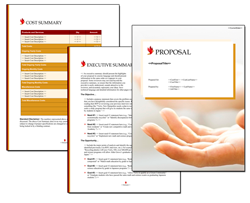
Top Tips on How to Write a Faith-Based Proposal
Need help writing a faith-based proposal? This guide will show you the essential steps: creating a cover letter, defining your project's needs, and aligning with funders' goals - ensuring your proposal stands out and secures vital support.
Key Takeaways
- Highlight critical components like the cover letter, executive summary, and statement of need to create a faith-based proposal.
- Align your project with funders' priorities through research and by analyzing grant databases and past projects.
- A detailed project plan, clear budget, and sustainability strategy can enhance credibility and demonstrate a project's long-term viability.
Understanding Faith-Based Proposals

Faith-based proposals focus on empowering communities through collaborative efforts rooted in shared values and spiritual beliefs. They share many similarities with nonprofit proposals and emphasize spiritual beliefs and values. These proposals typically include a cover letter, executive summary, statement of need, goals and objectives, methods and strategies, and their mission and values. When you write a faith-based proposal, it is important to highlight these elements effectively.
Understanding these core components will help you create a proposal, whether you work for a faith-based nonprofit or a religious organization.
Cover Letter
Your cover letter is the first impression funders will have of your proposal. Many private foundations have specific guidelines and objectives that your cover letter should align with to increase your chances of securing funding. It should succinctly convey your church's mission and align it with the grant's objectives to enhance its appeal. Read donor guidelines carefully and include your church's mission statement to help funders understand your core values and goals.
Ensure your letter aligns with the grant's objectives to improve your chances of securing funding.
Executive Summary
An effective executive summary must cover important elements like community needs and the church's capacity to use the grant. It should provide a snapshot of your proposal, including the problem you aim to address, your proposed solution, and the anticipated outcomes.
This section sets the stage for your proposal, engaging the reader and highlighting the value of your project.
Statement of Need

The statement of need is your opportunity to highlight the community problem you aim to address with the grant money. Clearly outline your need for money or material support to address the community problem effectively. Include details about the issue, its historical context, and supporting metrics to provide a comprehensive view. Citing facts from reputable sources, such as government reports or academic studies, can strengthen your proposal. While it's important to illustrate the issue's importance, avoid being overly negative; instead, focus on the potential for positive impact.
For instance, if your faith-based organization is seeking funding to support a homeless shelter, you might explain how the local homelessness rate has increased over the past decade and provide statistics to support your claims.
A clear picture of the need can appeal to funders' sense of urgency and compassion, increasing the likelihood of their support.
Aligning Your Proposal with Funders' Priorities
A well-structured grant proposal should align with the funders' missions and goals to increase the chances of acceptance.
Understanding and matching your project to the funders' missions and goals increases your proposal's chances of acceptance.
Research potential funders and create a grant prospect list to identify those whose priorities align with your project's objectives.
Use Grant Databases
Grant databases are invaluable tools for finding funding opportunities. Search for online resources that track available grants. These databases save time and enhance efficiency in locating and applying for relevant grants.
Additionally, grant management software can streamline the oversight and organization of multiple grant applications.
Analyze 990s and Press Releases

Analyzing 990 forms and press releases from potential funders can provide deep insights into their priorities and interests. These documents often reveal trends and funding patterns, which you can use to tailor your proposal effectively. If a funder has recently supported homelessness projects, highlight similar aspects in your proposal to align with their interests.
Press releases often announce new funding initiatives or highlight successful projects, providing clues about what the funder values most. By aligning your proposal with these insights, you increase the likelihood of securing your needed support.
Creating a Detailed Project Plan
A detailed project plan outlines your vision, mission, and steps to achieve your goals. A well-structured project plan conveys the purpose and details of your project and demonstrates your preparedness and organizational capabilities to potential funders.
Goals and Objectives
Your goals and objectives should be specific, measurable, and aligned with the funders' priorities. Including metrics allows you to track progress and demonstrate accountability.
For instance, if your goal is to provide Christmas toys and food to 500 families, clearly state this and outline how you plan to achieve it. This clarity shows funders the tangible impact of their support.
Methods and Strategies
Detail the specific steps to achieve your goals, the tools and personnel involved, and a clear timeline for implementation.
For example, if your project involves a children's vaccination program, explain how you will coordinate with local healthcare providers, what resources will be needed, and the expected outcomes. This level of detail reassures funders that you have a well-thought-out plan.
Budgeting and Sustainability
A clear budget and sustainability plan convince funders of your project's viability. Demonstrating fiscal responsibility and outlining post-grant sustainability can significantly enhance your proposal's appeal.
Budget Information

Your budget should be detailed and itemized, covering all projected costs from personnel to materials. A transparent budget helps funders understand how their money will be used and builds trust.
Simplify budget information with graphs, text, bullets, and clear headers.
Sustainability Plan
A well-defined sustainability plan illustrates how your project will continue to operate after initial funding ends. Incorporate strategies for enhancing sustainability through community resources and partnerships.
For example, if your project involves a vaccination program in Guatemala, detail how you will engage local healthcare providers and community leaders to ensure ongoing support.
Organizational Background and Credibility
A comprehensive organizational background and demonstrated credibility are crucial for gaining funders' trust. Highlighting your organization's history, achievements, and leadership can significantly strengthen your proposal.
Organizational Background
Include details about your church's history, membership demographics, and key metrics related to your activities. Engaging senior church members and family members to share unique perspectives and anecdotes can enrich your narrative and provide a deeper understanding of your organization's impact.
Quantifiable evidence of your church's growth and outreach efforts further enhances credibility.
Leadership and Partnerships

Funders want to know the experience and qualifications of your leadership team. Highlighting their expertise and successful track records reassures funders of your ability to manage grant funds effectively. Additionally, showcasing partnerships with other organizations can demonstrate a network of support and shared resources, strengthening your proposal.
For example, detailing collaborations with local nonprofits or community groups can illustrate your organization's ability to work well with others and expand its impact beyond its immediate reach.
Effective leadership and established partnerships significantly bolster your proposal's credibility.
Writing Tips and Best Practices
Adopting best practices dramatically enhances the quality and effectiveness of your submission. From starting with an outline to seeking feedback, these ideas can streamline the writing proposal process and improve your proposal's appeal.
Start With an Outline
An outline helps organize your thoughts and ensures clarity throughout your proposal. If the RFP requests specific information, include all required details explicitly. Pre-written templates guide you in structuring appropriate information for each section, enhancing the quality of your proposal.
The Proposal Kit software allows the rapid creation of proposal templates to match any RFP's requirements. You can also start with one of many layouts for faith-based and other nonprofit proposals and customize the layout as needed.
Be Clear and Concise
Clarity and conciseness are critical in proposals. Each section should be easily understandable, avoiding overwhelming funders with unnecessary details. Use short, impactful statements and visual aids like graphs and charts to clarify complex information.
Seek Feedback

Feedback from individuals outside your church can provide critical insights and enhance your proposal's effectiveness. Input from a broader audience ensures your proposal is clear and understandable to those unfamiliar with your organization. Incorporating external feedback addresses potential areas of confusion and improves appeal.
For example, ask a colleague from a different department or a partner organization to review your written proposal. Their fresh perspective can highlight unclear sections and suggest improvements, making your proposal stronger and more compelling.
Tools and Resources for Faith-Based Proposal Writing
The right tools and resources can significantly improve your grant writing proposal writing services process. Effective proposal writing tools streamline tasks, enhance organization, and improve the chances of securing funding for your faith-based projects.
Here are some related samples included in every downloadable Proposal Pack
The AI Writer generates a first draft of these templates - customized to your company, client, and project - in just minutes, giving you a head start on editing. Get any Proposal Pack or Proposal Kit Professional, and all of these samples, and the AI Writer are included.
- Educational Grant Sample Proposal
- Educational Grant Sample Proposal #2
- Non-profit Support Sample Proposal
- Research Assistant Sample Proposal
- Healthcare Grant Sample Proposal
- Church Mission Shelter Sample Proposal
- Auction Fundraiser Sample Proposal
- Research Funding Request Proposal
- Research Sample Proposal
- School Funding Request Sample Proposal
- Orphanage Non-Profit Funding Sample Proposal
Here are some related downloadable templates
The AI Writer generates a first draft of these templates - customized to your company, client, and project - in just minutes, giving you a head start on editing. Get any Proposal Pack or Proposal Kit Professional, and all of these templates and the AI Writer are included.
Pre-Written Templates and Samples
Pre-written templates simplify the proposal creation process and ensure that all necessary sections are included. They also standardize the writing process, making it easier to produce consistent quality.
Proposal Kit offers business proposal templates, layouts, and samples designed explicitly for faith-based proposals, helping nonprofit organizations save time and maintain high standards.
While Proposal Kit offers many pre-made templates, the best results come from using the Wizard software and template library, which allows for building custom, tailored proposals as needed.
Software Solutions

Proposal Kit's software solutions automate tasks such as building and customizing proposals, allowing you to focus on content quality. These tools also automate building schedules and various financial pages using a line-item database and streamline the proposal writing process.
Effective use of the Proposal Kit software ultimately improves your chances of securing funding.
Encouragement and Perseverance
Writing faith-based proposals is often challenging, but perseverance is key. Viewing rejections as learning opportunities fosters growth and resilience in your nonprofit work. The impact of your efforts might take time to be visible, but the long-term outcomes can be profound.
Community engagement often strengthens after challenges, creating deeper connections among members. A supportive network can help you stay motivated and focused on your mission despite setbacks. Every step forward is a step closer to making a significant impact.
Summary
Creating a faith-based proposal involves understanding its structure, aligning with funders' priorities, detailing a comprehensive project plan, and demonstrating financial responsibility. Following the steps outlined in this guide, you can create a proposal that resonates with funders and supports your mission. Stay encouraged and persevere, knowing your efforts can bring about meaningful change.
 Proposal Kit Professional provides the most content, including legal contracts and a free design theme pack. Plus, advanced software features include custom branding and customizable quoting databases.
Proposal Kit Professional provides the most content, including legal contracts and a free design theme pack. Plus, advanced software features include custom branding and customizable quoting databases. Proposal Pack for Any Business covers this type of proposal and includes samples. There are also some commonly used specialty design themes available:
Proposal Pack for Any Business covers this type of proposal and includes samples. There are also some commonly used specialty design themes available:Photo Design Proposal Packs
Line Art Design Proposal Packs
Frequently Asked Questions
What is a faith-based proposal?
Religious organizations create faith-based proposals to tackle community issues while promoting shared values and spiritual beliefs. It's a way to create positive change rooted in faith. The structure of the proposal is the same as any other proposal but usually with extra chapters to cover the organization's mission and values.
Why is a cover letter important in a faith-based proposal?
A cover letter is crucial in a faith-based proposal because it communicates your church's mission and connects it to the grant's goals, making your application more compelling. This alignment can significantly enhance your chances of success.
How can I find potential funders for my faith-based proposal?
Explore grant databases online to find potential funders that match your faith-based project's mission. Search online for websites that track available non-profit and faith-based grants. This targeted approach will connect you with organizations that resonate with your vision.
What should be included in the statement of need?
Your statement of need should clearly outline the community problem you're tackling, backed by solid details and metrics from trustworthy sources. This not only shows the significance of the issue but also strengthens your case.
How can I ensure the sustainability of my project after the grant period ends?
To ensure your project's sustainability after the grant ends, create a solid sustainability plan that outlines how you'll leverage community resources and partnerships for ongoing support. This clear strategy will help your project thrive even after funding is over.



 Cart
Cart
 Are you just looking for a template, sample, or software for your faith-based proposals? Click these links to skip down the page and get right to it.
Are you just looking for a template, sample, or software for your faith-based proposals? Click these links to skip down the page and get right to it.











 Facebook
Facebook YouTube
YouTube Bluesky
Bluesky Search Site
Search Site